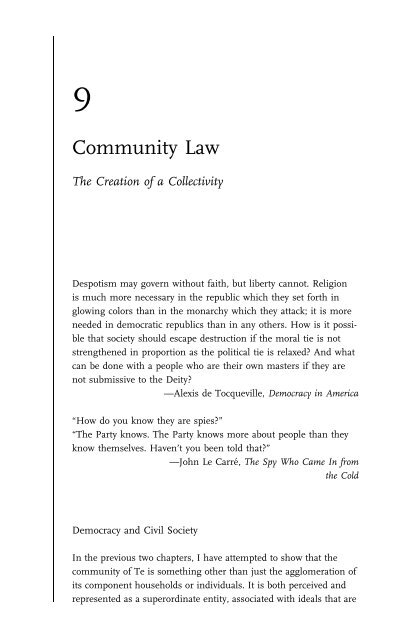Navel of the Demoness : Tibetan Buddhism and Civil Religion in ...
Navel of the Demoness : Tibetan Buddhism and Civil Religion in ...
Navel of the Demoness : Tibetan Buddhism and Civil Religion in ...
Create successful ePaper yourself
Turn your PDF publications into a flip-book with our unique Google optimized e-Paper software.
clan should give <strong>the</strong> village one field <strong>of</strong> its collective property per household <strong>of</strong><br />
its clan—six <strong>of</strong> <strong>the</strong>m, to judge by <strong>the</strong> number <strong>of</strong> <strong>the</strong> signatories. Alternatively,<br />
it may mean that each household <strong>of</strong> <strong>the</strong> Cimden clan should give <strong>the</strong> village<br />
one <strong>of</strong> <strong>the</strong> fields from its own private estate. But if it is a question <strong>of</strong> <strong>in</strong>dividual<br />
property, it becomes very difficult to expla<strong>in</strong> why <strong>the</strong> Cimden clan as a whole<br />
should have been s<strong>in</strong>gled out for this treatment, s<strong>in</strong>ce <strong>the</strong> document is obviously<br />
aimed at curtail<strong>in</strong>g <strong>the</strong> disproportionate wealth <strong>of</strong> <strong>the</strong> group. It is apparent<br />
that <strong>the</strong> problem can only be tackled if we know someth<strong>in</strong>g about <strong>the</strong><br />
relationship between clans <strong>and</strong> <strong>the</strong> <strong>in</strong>heritance <strong>of</strong> l<strong>and</strong>ed property.<br />
Categories <strong>of</strong> Households<br />
fromclanstohouseholds<strong>in</strong>te 125<br />
Households <strong>in</strong> Te are, broadly, <strong>of</strong> two types, which I shall call estates <strong>and</strong><br />
dependencies. The term for estate is drongba (Tib. grong pa), <strong>the</strong> usual term <strong>in</strong><br />
Lo <strong>and</strong> Baragaon—<strong>and</strong> <strong>in</strong> much <strong>of</strong> Tibet—for this k<strong>in</strong>d <strong>of</strong> household. An estate<br />
essentially consists <strong>of</strong> a house <strong>and</strong> a number <strong>of</strong> fields scattered through <strong>the</strong><br />
agricultural l<strong>and</strong> <strong>of</strong> <strong>the</strong> village. In addition, <strong>the</strong>re may be one or more smaller<br />
build<strong>in</strong>gs, not necessarily attached to <strong>the</strong> ma<strong>in</strong> house, a thresh<strong>in</strong>g yard or two,<br />
some fruit trees, <strong>and</strong> a stone corral for penn<strong>in</strong>g dzos <strong>in</strong> <strong>the</strong> central gorge—not<br />
to mention livestock <strong>and</strong> o<strong>the</strong>r moveable property that a house conta<strong>in</strong>s. There<br />
are forty-eight estates <strong>in</strong> Te, <strong>and</strong> have been for as long as anyone can remember.<br />
Two <strong>of</strong> <strong>the</strong> estates have no owners, <strong>and</strong> although <strong>the</strong>ir fields are apportioned<br />
out for use by o<strong>the</strong>r estates, <strong>the</strong>y have never<strong>the</strong>less not been dissolved:<br />
<strong>the</strong>y are village property, <strong>and</strong> can be ‘‘reactivated’’ as whole entities if <strong>the</strong> community<br />
so decides. In fact <strong>the</strong>y have both recently been reactivated <strong>in</strong> a limited<br />
way, but I shall discuss <strong>the</strong> ra<strong>the</strong>r complex circumstances <strong>of</strong> <strong>the</strong>ir operation<br />
later.<br />
A man becomes <strong>the</strong> head <strong>of</strong> his household after <strong>the</strong> withdrawal <strong>of</strong> his<br />
fa<strong>the</strong>r from <strong>the</strong> position. This transition corresponds approximately to <strong>the</strong><br />
latter’s retirement ceremony, but is less rigidly enforced than <strong>the</strong> withdrawal<br />
from public life. A dynamic fa<strong>the</strong>r whose son is a relatively weak character, or<br />
generally <strong>in</strong>competent, may cont<strong>in</strong>ue to function as <strong>the</strong> head <strong>of</strong> <strong>the</strong> estate well<br />
<strong>in</strong>to old age. Marriages are ma<strong>in</strong>ly monogamous, but <strong>the</strong>re are a few examples<br />
<strong>of</strong> fraternal poly<strong>and</strong>ry. This system <strong>of</strong> marriage—very typical for much <strong>of</strong> Tibet<br />
<strong>and</strong> <strong>the</strong> <strong>Tibetan</strong>-speak<strong>in</strong>g Himalaya—was once very common <strong>in</strong> Baragaon <strong>and</strong><br />
Lo but is now <strong>in</strong>creas<strong>in</strong>gly rare. Estates are <strong>in</strong>herited <strong>in</strong> <strong>the</strong> male l<strong>in</strong>e, but <strong>the</strong>y<br />
are never subdivided among a group <strong>of</strong> bro<strong>the</strong>rs. The normal pattern <strong>in</strong> Baragaon<br />
is that <strong>the</strong> eldest bro<strong>the</strong>r <strong>in</strong>herits <strong>and</strong> becomes <strong>the</strong> head <strong>of</strong> <strong>the</strong> household.<br />
If his younger bro<strong>the</strong>r or bro<strong>the</strong>rs wish to jo<strong>in</strong> him <strong>in</strong> a poly<strong>and</strong>rous


